The Lumpy Skin Disease (LSD) outbreaks of 2022 had devastating impact on animal health and livelihoods of livestock farmers across India.In this blog, Devesh Thakur and Atul Gupta look at the handling of LSD outbreaks across various states of India and the lessons that we need to learn so that this disease does not impact livestock-based livelihoods in future.
THE CONTEXT
Lumpy Skin Disease (LSD) is an economically devastating disease categorised as a notifiable disease by the World Organization for Animal Health. India has witnessed unprecedented economic loss due to LSD outbreaks this year.The first outbreak of LSD was reported from Odisha, in August 2019. Subsequently cases were reported from Madhya Pradesh, Kerala and Assam in 2020.However, not much was learnt and this year the country had to face large scale devastation from this disease. According to government estimates, over 2.4 million animals were infected and over 110,000 cattle died due to this disease in India (BBC, October 19 2022). In this blog, we discuss the possible factors associated with the spread of disease, the roles played by major stakeholders in the management of LSD across several affected states, and the actions that are necessary to address similar crises in the future.
SPREAD OF LUMPY SKIN DISEASE IN INDIA
Lumpy Skin Disease (LSD) is caused by the lumpy skin disease virus (LSDV), a virus from the family Poxviridae, genus Capripoxvirus. Sheeppox virus and goat pox virus are the two other virus species in this genus. LSD is endemic in most African countries. Since 2012, it has spread rapidly through the Middle East, southeast Europe, and West and Central Asia. In Asia, the emergence of LSD was first reported from Bangladesh, in mid-2019 (Hasib et al. 2021). Then it spread to India, Bhutan, Nepal, Hong Kong, Vietnam, Myanmar, and Thailand (Shah and Khan2022).
In August 2019, the first outbreak of LSD was reported from Odisha, India (Gupta et el. 2020). Subsequently cases were reported from Madhya Pradesh, Kerala and Assam in 2020 (Pandey etal. 2022 and Shagun et al. 2021). This May, Kaiyari village in Lakhpat Taluka of Kutch region of Gujarat reported the initial outbreak (USDA 2022; report dated August 9 2022). Then it spread to Rajasthan and further up to the northern states of Punjab, Haryana, and Himachal Pradesh (USDA 2022 report of August 12 2022). Then it spread like wildfire across 251 districts in 15 states and affected over two million animals. Gujarat, Rajasthan, Punjab, Uttarakhand, Himachal Pradesh, Madhya Pradesh, Jammu & Kashmir, Uttar Pradesh, Haryana, Maharashtra, Goa, West Bengal, Andhra Pradesh, Delhi, and Bihar have been affected. According to government estimates over 2.4 million animals were infected and over 110,000 died due to this disease in India (BBC, October 19 2022). Thus, India has suffered unprecedented economic loss (Box 1) due to Lumpy Skin Disease outbreaks this year.
|
Box 1: Economic loss from this deadly epidemic Milk production dropped significantly in some states (Milk collection by Rajasthan Co-operative Dairy Federation was reduced by 3-4 lakh litre per day in September when compared to June this year (Press Trust of India: Milk collection in Rajasthan reduced by 3 to 4 lakh litre per day due to lumpy skin disease [ptinews.com]). |
CONTAINING 2022 LSD OUTBREAK IN INDIA: ROLE OF DIFFERENT STAKEHOLDERS
State animal husbandry departments of various state governments remained a front line organisation in the management of LSD outbreaks across the country. Aside from the departments of animal husbandry and dairying, Ministry of fisheries, Government of India, different state agricultural/veterinary universities, NGOs, gaushalas, municipal bodies, panchayats, mass media channels and district administration played important roles in the management of disease outbreaks.
State animal husbandry department
The veterinarians and para-veterinary staff of state animal husbandry departments played an extremely important role in prevention and control of this disease. Their role has been primarily divided into three important aspects – spreading awareness about diseases prevention, vaccination, and treatment of cattle.
Vaccination programme
Vaccinating animals was an important activity undertaken by veterinary doctors and para-veterinary staff across the country. Nearly sixty million cattle were vaccinated in the LSD vaccination drive in India against a target of 250 million (LSD: Testing times for dairy farmers, vax makers – The Hindu BusinessLine). The vaccination programme was affected due to shortage of veterinary manpower in various states.In some states, such as Maharashtra, private veterinary doctors, and retired animal husbandry officers were asked to volunteer in the Lumpy Skin Disease vaccination campaign. Further, in Maharashtra final year students, internees and PG scholars were also roped in for administering vaccines and holding awareness programmes.
Awareness measures
Personnel from the state department of animal husbandry played an important role in various awareness drives against LSD through toll free numbers, pamphlets, loudspeakers, public meetings and mass media. Several state departments of animal husbandry (Maharashtra, Haryana, Delhi, and regions of J & K) initiated toll free services for help, advice and disease reporting. Some of the state departments, such as Himachal Pradesh, used daily report charts and useful material for awareness among farmers through its web portal. (hpagrisnet.gov.in/hpagris/AnimalHusbandry/Default.aspx?SiteID=3&PageID=1494)
The departments of animal husbandry in Karnataka and Uttarakhand used social media tools to build awareness among farmers.
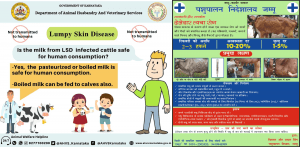 Awareness drive by different State Departments of Animal Husbandry
Awareness drive by different State Departments of Animal Husbandry
Treatment of infected cattle
Treatment of sick animals was another important aspect that was taken care of by veterinarians across the affected states. Mobile veterinary clinics and rapid response teams were also set up to treat animals and build awareness among farmers.In certain states, such as Delhi, veterinary hospitals were equipped with a special isolation ward and a 24-hour emergency helpline number to tackle the spread of virus among cows. A special isolation ward in the Rewla-Khanpur area was set upto treat the infected animals. Arrangements were ensured for isolation spaces in case the owner/caretaker does not have enough space to isolate their infected cattle.
Immediate reporting of diseases, such as LSD, by veterinarians is extremely critical. Case study from FAO, Indonesia (Box 2) underlines the importance of early disease reporting.
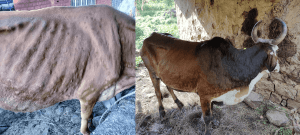 LSD affected cattle
LSD affected cattle
|
Box 2: A reasonable doubt saves livelihoods of thousands of farmers Immediately, Nuryadi, reported this suspicious disease to the authorities of Indragiri Hulu District, in Riau province of Indonesia. Not long after that, the Government of Indonesia officially reported the outbreak to the World Organization of Animal Health (OIE) on March 2 2022. At that time, LSD had already infected Malaysia, Singapore, Thailand and other countries in Asia. The outbreak report from Indonesia had further alerted other neighbouring countries,such as Australia, which has a large cattle industry. The emergency reporting chain then reached the governor of Riau and eventually the Minister of Agriculture. But simultaneously Pariza’s team alerted the national information system for animal health (iSIKHNAS). She also worked with Disease Investigation Centre of Bukittinggi to take samples and detect the suspicious disease, which then confirmed it as Lumpy Skin Disease. The government launched emergency vaccination programme on 17 March 2022 as one of the disease control strategies, along with community education campaigns, vector control, cattle movement restriction, surveillance and early detection in Riau and neighbouring providnces. Pariza hoped that her experience would alert other regions around the world: “If in the slightest oddness one finds symptoms of a suspicious disease, please immediately follow the emergency alert system in place. It will save farmers at home and other countries from financial loss and save the public from food supply disruptions.” Source:FAO in Indonesia,22/4/22 |
State Governments & District Administration
State governments in general and district administration in particular are the second important stakeholders in LSD management. Various state governments and district administration stopped all animal gatherings by banning animal fairs, for example, in the last week of July Gujarat State banned all animal fairs. The district administrations in some parts of the state issued notifications to ban the movement of cattle from other states, districts, taluks and cities. Similarly, Maharashtra government declared the whole state as a ‘controlled area’ to curb the spread of LSD in cattle on September 9 2022. On similar lines UP banned cattle trade with four neighbouring states and also imposed a ‘lockdown’ on intrastate movement of animals from 28 districts to prevent the spread of this disease on September 22 2022.
Municipal Bodies & Panchayats
Managing an LSD outbreak requires huge human effort. The role of local civic bodies, such as panchayats and municipal bodies is imperative in the disposal of animal carcasses. Certain Municipal Corporations in parts of Patiala (Punjab) and Jaipur offered helpline numbers/WhatsApp helpline for proper disposal of carcasses. However, in many regions there were reports of people unable to dispose the cattle properly and heaps of cattle carcasses remained at open sites. On the other hand certain municipal corporation followed proper disease management protocols by complete fogging at all gaushalas falling under its jurisdiction (Lumpy skin disease: Panchkula MC completes fogging at all gaushalas: The Tribune India).
Research & educational institutions
ICAR’s National Research Centre on Equines (NRCE) at Hisar, Haryana, and the Indian Veterinary Research Institute (IVRI) at Izatnagar, UP, developed vaccine against the Lumpy Skin Disease (LSD) virus. Later on, the technology was sanctioned by the research institutes for commercial use to vaccine manufacturers. Further,in a bid to decentralise the LSD testing/screening the Government of India in its notification allowed LSD testing across various veterinary colleges of the affected states across the country on September 14 2022.Internationally the World Organisation provided guidance and communication material for local veterinarians and animal health workers. Similarly, it also offered communication material for cattle owners, dairy farmers and dairy animal traders. Besides, it also provided Frequently Asked Questions (FAQ) on LSD for the public and veterinary services. The FAQs on LSD were offered on June 2022 while FAQs on vaccination were released on September2022. The Government of India through Vikaspedia portal offered guidelines for prevention of LSD ( Guidelines for prevention of Lumpy Skin Disease — Vikaspedia). Likewise various state agricultural/veterinary universities offered expert advice through field visits and advisories to the farmers.
Mass media
Mass media, including social media, played an extremely important part in reporting and highlighting the LSD problem in the country.Down to Earth, the leading science magazine forewarned about possible havoc the disease could cause in the country on January 13 2021 (Shagun et al. 2021). A national daily, The Hindu (July end to mid-August) started by reporting on the disease spread from August 2022. The daily started providing information about disease etiology, spread, and control in various articles from September. Another prominent newspaper, The Indian Express published its first article about this disease: ‘What is Lumpy Skin Disease? (indianexpress.com) on August 12 2022. It also reported regularly about the threat the disease posed to the livestock-based economy of the country. A prominent Hindi daily, Amar Ujala started reporting on the disease in its regional town/city wise editions from August 2022. The national channel for farmers, DD Kisan, telecasted two programmes on this disease on July 24 2022 and August 21 2022 under its Apna Pashu Chikitsak programme.
On the other side, several lies and rumours about disease transmission to humans through consumption of milk from LSD-infected cattle through social media also spread rapidly. This misinformation created panic among consumers and farmers (Box 3).
|
Box 3: Misinformation about LSD on social media |
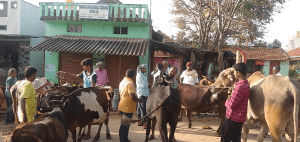 Cattle Owners assemble for vaccination at Rural Karnataka
Cattle Owners assemble for vaccination at Rural Karnataka
The spread of LSD was contained at India’s milk capital, Anand, when compared to Gujarat and other affected states of India. This case study can be a roadmap for containing spread of LSD or similar livestock disease epidemics in the country (see Box 4).
|
Box 4: How the ‘milk capital’ prevented disease spread Artificial insemination experts in the district also double up as first responders when a case is reported in a village. As a result, the infections are detected at an early stage, preventing further spread. The nutritional profile of the cattle was also better than those at gaushalas or on the street. “Just like in humans, well-nutritioned cattle are able to fight the disease better. At gaushalas, the cattle may be well fed, but they often do not get the nutritional supplements that cows reared for dairy get in Anand.” |
FACTORS WHICH LED TO SPREAD OF DISEASE AND ASSOCIATED GAPS
Early warning signs ignored
Early warning signals about the spread of disease in Kerala and several other states of southern and central India were not taken seriously as possible nationwide spread was predicted earlier by Down to Earth, a leading science magazine in its article published on January 13 2021 (Shagun etal.2021). The Government of India itself had admitted that lumpy skin disease was one of the three major disease outbreaks the country had witnessed over last three years in its press statement on December 14 2021 (PIB 2021). Yet one could not prevent the mammoth scale of spread of this disease. Scientific evidence showed that once the disease is detected in a region or country, stand still and quarantine are the very first measures to be undertaken quickly (Tuppurainenet al.2017). However, despite possible outbreaks and advisories, proper protocols on movement of cattle in the country did not follow. Cattle movement across borders and interstate/region movement continued without due consideration even after the earlier outbreaks of 2020 and 2021.The situation could have been averted by restricting the movement of cattle and launching early awareness and vaccination drive in the country.
LSD spread faster among cattle markets, gaushalas and stray cattle
The role of cattle markets, gaushalas and stray cattle remains particularly important in the spread of LSD in India. Weekly cattle markets and communal grazing allowed animals to mix freely without effective biosecurity controls. Purchased livestock by farmers resulted in the regular and frequent entry of new animals into villages. In the earlier stage, lack of awareness among farmers also led to ignoring the disease as many farmers thought of the disease symptoms as possible skin allergies or minor infections.
In cities of Gujarat and Rajasthan, LSD spread rapidly among stray cattle and gaushalas. This happened due to weak nutritional and immunological status of animals. In several gaushalas of cities hundreds of animals packed together led to worse LSD situation among city cattle (Basu 2022). In villages, for example in Kutch of Gujarat, open communal grazing led to the spread of disease. Farmers also ignored the need to segregate the affected cattle from healthier ones owing to traditional way of open grazing.
Shortfall in vaccination delivery
Pre-emptive vaccination is highly recommended when LSD is detected across borders in neighbouring countries. However, even after outbreaks the vaccination efforts have been far from satisfactory, for example, till September 10, 2022 vaccination of bovines was yet to commence in seven districts of Rajasthan. Even the Union Animal Husbandry minister pointed out that Rajasthan was the worst affected state and had achieved only 40% vaccination from all the total doses available (Devdiscourse2022).
Lack of sufficient veterinary care and medicines
Lack of proper veterinary care, lack of medicines, food for sick cattle, and proper disposal of dead cattle were major shortcomings faced by cattle owners andanimal handlers across several regions of the country. Acute shortage of antibiotics and vaccines was reported by animal husbandry officials in district Kangra, Himachal Pradesh (Tribune News, 2022). Several states, such as Delhi, Karnataka, Himachal Pradesh, Gujarat, and Jammu &Kashmir reported shortage of veterinary doctors and other infrastructural facilities. As a result, farmers faced huge livelihood losses (Basu 2022).
LEARNING FROM THE CRISIS: NEEDED ACTIONS
Based on our experiences with containing LSD spread, we need to consider the following actions in order to be prepared for dealing with similar crises in the future.
Bringing LSD under the Ambit of NADCP
Experiences of countries (Israel and Balkan region of Europe)with successful LSD control and eradication suggest that repeated annual vaccination for several years after the cessation of clinical cases is the best possible measure to be undertaken (MitikuT 2022). Given that vaccination offers year-long protection against LSD it becomes imperative that the vaccination for lumpy skin disease may be brought under the ambit of National Animal Disease Control Programme (NADCP). This program, launched in September 2019, currently covers two of most important infectious diseases – Brucellosis and FMD – in India. Private players can be roped in for forming start-ups to offer vaccination for LSD and other infectious diseases. This will not only meet the shortage of animal vaccinators in the country but also improve the state of livestock vaccination in the country. Instead of presently used heterologous Goat pox vaccine, vaccination through homologous vaccine developed by ICAR –NRC Equine & ICAR IVRI may be put to use as early as possible as ICAR itself has admitted that heterogonous vaccines provide partial protection and are not as efficacious as homologous vaccines (https://www.thehindu.com/news/national/icar-develops-vaccine-for-lumpy-skin-disease-in-cattle/article65754097.ece).
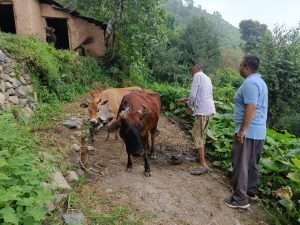 Cattle owner with affected animal
Cattle owner with affected animal
Disinfection and surveillance of livestock markets and gaushalas
Studies in African countries where LSD has been endemic have suggested that livestock markets are potential hubs of virus transmission.But these places, at the same time, can be a potential place to implement surveillance and control measures. Therefore, measures such as separating affected animals as well as animals coming from affected herds or flocks in livestock markets, disinfecting, fumigation livestock markets during closing dates and awareness generation would help to reduce the transmission rate of disease among livestock. Rapid screening tests for disease is an area which may looked into for effective disease surveillance. Further proper monitoring of trade, transport of cattle along with health checks by setting up security check posts manned by veterinarians must be put into place to prevent spread of LSD (Limon et al.2020).
Massive extension awareness
Massive extension efforts are needed among farmers to take informed decisions when purchasing animals.Efficient disease control is impossible without good cooperation among farmers and other cattle value chain actors. The awareness campaigns should be targeted atveterinarians, veterinary students, farmers, herders, cattle traders, cattle truck drivers and artificial inseminators.The FAO suggests that certain individuals, such as cattle truck drivers, are in a particularly good position to identify infected animals on farms, in slaughterhouses, or at cattle collection and resting stations and to notify veterinary authorities about any clinical suspicion as soon as possible (Tuppurainenet al.2017). Therefore, targeted extension awareness strategy may work well in the prevention and control of LSD outbreaks in future.
Use of PashuSakhis under A-HELP Programme
Though laboratory confirmation of causative agent and its isolation are helpful in epidemiological investigations of infectious diseases such as LSD. Often, such facilities are not readily available or affordable in rural India. Alternatively, rural animal health workers such as PashuSakhis under A-HELP programme launched by the Government of India can collect necessary clinical and epidemiological data quickly and reliably while offering immediate advice to animal keepers.
Setting up emergency drug banks
LSD being a trans boundary animal disease, requires massive veterinary infrastructural support. Emergency drug banks may be created at district or block veterinary hospitals to tackle shortage of medicines during such outbreaks. Frequent health check-ups of cattle in all districts and village veterinary hospitals should be conducted with free treatment of cattle.
References
Basu M. 2022. In Kutch camps, sick cows gnash teeth, flies cover wounds, as they wait to die of Lumpy Skin Disease. The Print, 6 August 2022. https://theprint.in/india/in-kutch-community-run-cattle-care-camps-come-up-as-cows-die-of-lumpy-skin-disease-in-gujarat/1071516/.
BBC. 2022.Lumpy skin disease: Viral cattle disease sends rumours flying in India – BBC News
Devdiscourse. 2022. Lumpy Skin Disease in cattle more serious in Rajasthan: Union Minister Sanjeev Balyan | Science-Environment. https://www.devdiscourse.com/article/science-environment/2186698-lumpy-skin-disease-in-cattle-more-serious-in-rajasthan-union-minister-sanjeev-balyan. Accessed 28 Oct. 2022.
Gupta T, Patial V, Bali D, et al. 2020. A review: Lumpy Skin Disease and its emergence in India. Vet Res Commun 44:111–118. https://doi.org/10.1007/s11259-020-09780-1
Hasib FMY, Islam MS, Das T, Rana EA, Uddin MH, Bayzid M, … andAlim MA. 2021. Lumpy Skin Disease outbreak in cattle population of Chattogram, Bangladesh. Veterinary Medicine and Science 7(5):1616-1624.
Limon G, Gamawa AA, Ahmed AI, Lyons NA andBeard PM. 2020. Epidemiological characteristics and economic impact of lumpy skin disease, sheep pox and goat pox among subsistence farmers in northeast Nigeria. Frontiers in Veterinary Science 7, 8.
Mitiku T. 2022. Current status of Lumpy Skin Disease and its economic impacts in Ethiopia. J Vacc Res 1:103.
Molla W, de Jong MC, Gari G and Frankena K. 2017. Economic impact of Lumpy Skin Disease and cost effectiveness of vaccination for the control of outbreaks in Ethiopia. Preventive Veterinary Medicine 147:100-107.
Pandey N, Hopker A, Prajapati G, Rahangdale N, Gore K and Sargison N. 2022. Observations on presumptive Lumpy Skin Disease in native cattle and Asian water buffaloes around the tiger reserves of the Central Indian highlands. New Zealand Veterinary Journal 70(2):101-108.
PIB. 2021.Outbreaks of disease among cattle. Government of India.https://pib.gov.in/pib.gov.in/Pressreleaseshare.aspx?PRID=1781378. Accessed 28 Oct. 2022.
Shagun Shaji KA, Panda A, and Chakravartty A. 2021.Lumpy Skin Disease: The deadly pandemic that has taken root among India’s bovines. Down to Earth January13, 2021. https://www.downtoearth.org.in/news/agriculture/lumpy-skin-disease-the-deadly-pandemic-that-has-taken-root-among-india-s-bovines-75037. Accessed 28 Oct. 2022.
Shagun. 2022, Ground report: Lumpy Skin Disease has created a livelihood crisis for India’s small dairy farmers. September 30,2022.
Shah SH and Khan M. 2022. Lumpy Skin Disease emergence in Pakistan, a new challenge to the livestock industry. J Vet Sci. 23(5):e77. https://doi.org/10.4142/jvs.22173
Tribune News. 2022. Cattle afflicted with Lumpy Skin Disease, Kangradairy farmers suffer huge losses. Tribuneindia News Service. https://www.tribuneindia.com/news/himachal/cattle-afflicted-with-lumpy-skin-disease-kangra-dairy-farmers-suffer-huge-losses-428063. Accessed 28 Oct. 2022.
Tuppurainen E, Alexandrov T and Beltrán-Alcrudo DJF AP. 2017. Lumpy Skin Disease-a manual for veterinarians. FAO Animal Production and Health Manual (20).
USDA. 2022. Update – Lumpy Skin Disease spreads to northern states of India. Report Number: IN2022-0070 Date: August 12, 2022. Download Report By File Name (usda.gov)
 Devesh Thakur, Assistant Professor, Department of Veterinary & AH Extension Education, Dr DGCN College of Veterinary & Animal Sciences, CSKHPKV Palampur, Himachal Pradesh. He can be reached at Email: drdth4@gmail.com
Devesh Thakur, Assistant Professor, Department of Veterinary & AH Extension Education, Dr DGCN College of Veterinary & Animal Sciences, CSKHPKV Palampur, Himachal Pradesh. He can be reached at Email: drdth4@gmail.com
 Atul Gupta, Assistant Professor, Department of Veterinary Public Health and Epidemiology, DGCN College of Veterinary and Animals Sciences, CSK HP Agricultural University, Palampur (Himachal Pradesh).He can be reached at Email: dratul9@gmail.com
Atul Gupta, Assistant Professor, Department of Veterinary Public Health and Epidemiology, DGCN College of Veterinary and Animals Sciences, CSK HP Agricultural University, Palampur (Himachal Pradesh).He can be reached at Email: dratul9@gmail.com

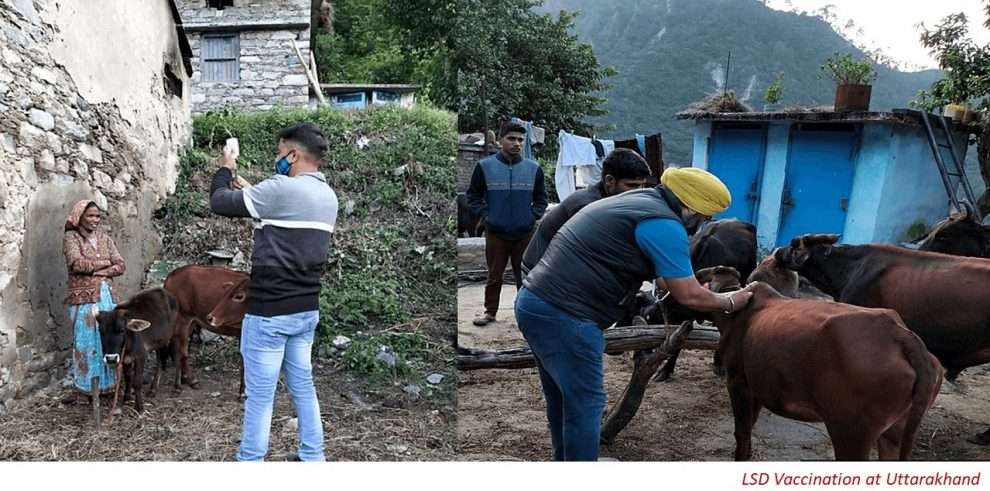

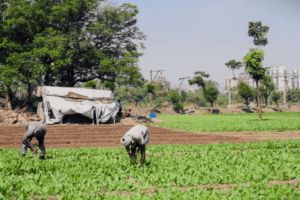

I congratulate Drs. Devesh Thakur and Atul Gupta for this comprehensive and timely blog on Lumpy Skin Disease. As pointed out by the authors, we ignored the early warning signals that led to the spread of this disease.
Even now the cases of LSD and African Swine Fever are being reported in several parts of the country. I do agree with the authors that LSD should be brought under NADCP and efforts must be made to produce the required doses of vaccine.
In my view these types of diseases will occur in the future and all the concerned stakeholders must be prepared to address this challenge to save the livestock farmers from the economic losses due to mortality as well as morbidity.
Thanks to AESA for posting this blog.
“Thank you very much for sharing this interesting, informative and concise Blog on Lumpy Skin Disease (LSD). I will take the liberty of sharing the Blog with colleagues from various organisations – Universities, NGOs etc.
I wish the authors would have analysed data on LSD for ‘a Clearer Picture in respect of:
(a) Differences between Indigenous and High & Low grade Exotic Crosses amongst cattle in relation to Susceptibility and Response to Treatment and
(b) What are the other species of Livestock that can get infected by LSD.
Thanks and best wishes”